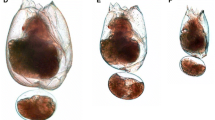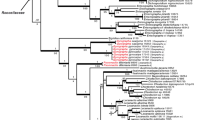Abstract
The past decade has seen the application of DNA sequence data to phylogenetic investigations of Rotifera, both expanding and challenging our understanding of the evolution of the phylum. Evidence that Acanthocephala, long regarded as a separate but closely related phylum, is a highly derived class of Rotifera demonstrates the potential of molecular analyses to suggest relationships not obvious from morphological analysis. Phylogenies based on the sequence of the gene for the small ribosomal RNA suggest that rotifers and acanthocephalans are associated with Platyhelminthes and Gastrotricha, perhaps in a clade with Gnathostomula and Cycliophora; at present, this group lacks a clear morphological synapomorphy. A more complete resolution of the molecular phylogeny of Rotifera will require surveying multiple genes and several species from each clade under investigation.
Similar content being viewed by others
References
Abouheif, E., R. Zardoya & A. Meyer, 1998. Limitations of metazoan 18S rRNA sequence data: implications for reconstructing a phylogeny of the animal kingdom and inferring the reality of the Cambrian explosion. J. Mol. Evol. 47: 394–405.
Aguinaldo, A. M. A., J. M. Turbeville, L. S. Linford, M. C. Rivera, J. R. Garey, R. A. Raff & J. A. Lake, 1997. Evidence for a clade of nematodes, arthropods and other molting animals. Nature 387: 489–493.
Ahlrichs, W. H., 1997. Epidermal ultrastructure of Seison nebaliae and Seison annulatus, and a comparison of epidermal structures within the Gnathifera. Zoomorphology 117: 41–48.
Balavoine, G., 1997. The early emergence of platyhelminths is contradicted by the agreement between 18S rRNA and Hox genes data. Comp. Rendus III 320: 83–94.
Campos, A., M. P. Cummings, J. L. Reyes & J. P. Laclette, 1998. Phylogenetic relationships of platyhelminthes based on 18S ribosomal gene sequences. Mol. Phylogenet. Evol. 10: 1–10.
Carranza, S., J. Baguñà & M. Riutort, 1997. Are the platyhelminthes amonophyletic primitive group? An assessment using 18S rDNA sequences. Mol. Biol. Evol. 14: 485–497.
Cavalier-Smith, T., 1998. A revised six-kingdom system of life. Biol. Rev. 73: 203–266.
Cummings, M. P., S. P. Otto & J. Wakeley, 1995. Sampling properties of DNA sequence data in phylogenetic analysis. Mol. Biol. Evol. 12: 814–822.
Felsenstein, J., 1978. Cases in which parsimony and compatibility methods will be positively misleading. Syst. Zool. 27: 401–410.
Felsenstein, J., 1988. Phylogenies from molecular sequences: inferences and reliability. Ann. Rev. Genet. 22: 521–565.
García-Varela, M., G. Pérez-Ponce de León, P. de la Torre, M. P. Cummings, S. S. S. Sarma & J. P. Laclette, 2000. Phylogenetic relationships of Acanthocephala based on analysis of 18S ribosomal RNA gene sequences. J. Mol. Evol. 50: 532–540.
Garey, J. R., T. J. Near, M. R. Nonnemacher & S. A. Nadler, 1996. Molecular evidence for Acanthocephala as a subtaxon of Rotifera. J. Mol. Evol. 43: 287–292.
Garey, J. R., A. Schmidt-Rhaesa, T. J. Near & S. A. Nadler, 1998. The evolutionary relationship of rotifers and acanthocephalans. Hydrobiologia 387/388: 83–91.
Giribet, G. & C. Ribera, 1998. The position of arthropods in the animal kingdom: a search for a reliable outgroup for internal arthropod phylogeny. Mol. Phylogenet. Evol. 9: 481–488.
Giribet, G. & W. C. Wheeler, 1999. The position of arthropods in the animal kingdom: Ecdysozoa, islands, trees and the ‘parsimony ratchet.’ Mol. Phylogenet. Evol. 13: 619–623.
Giribet, G., D. L. Distel, M. Polz, W. Sterrer & W. C. Wheeler, 2000. Triploblastic relationships with emphasis on the acoelomates and the position of Gnathostomulida, Cycliophora, Platyhelminthes and Chaetognatha: a combined approach of 18S rDNA sequences and morphology. Syst. Zool. 49: 539–562.
Graybeal, A., 1998. Is it better to add taxa or characters to a difficult phylogenetic problem? Syst. Biol. 47: 9–17.
Halanych, K.M., 1998. Considerations for reconstructing metazoan history: signal, resolution and hypothesis testing. Am. Zool. 38: 929–941.
Halanych, K. M., J. D. Bacheller, A. M. A. Aguinaldo, S. M. Liva, D. M. Hillis & J. A. Lake, 1995. Evidence from 18S ribosomal DNA that lophophorates are protostome animals. Science 267: 1641–1643.
Hancock, J. M. & A. P. Vogler, 2000. How slippage-derived sequences are incorporated into rRNA variable-region secondary structure: implications for phylogeny reconstruction. Mol. Phylogenet. Evol. 14: 366–374.
Hanelt, B., D. Van Schyndel, C. M. Adema, L. A. Lewis & E. S. Loker, 1996. The phylogenetic position of Rhopalura ophiocomae (Orthonectida) based on 18S ribosomal DNA sequence analysis. Mol. Biol. Evol. 13: 1187–1191.
Hashimoto, T., Y. Nakamura, F. Nakamura, T. Shirakura, J. Adachi, N. Goto, K. I. Okamoto & M. Hasegawa, 1994. Protein phylogeny gives a robust estimation for early divergences of eukaryotes: phylogenetic place of a mitochondria-lacking protozoan, Giardia lamblia. Mol. Biol. Evol. 11: 65–71.
Håstad, O. & M. Björklund, 1998. Nucleotide substitution models and estimation of phylogeny. Mol. Biol. Evol. 15: 1381–1389.
Hendy, M. D. & D. Penny, 1989. A framework for the quantitative study of evolutionary trees. Syst. Zool. 38: 297-309.
Hickson, R. E., C. Simon & S. W. Perrey, 2000. The performance of several multiple-sequence alignment programs in relation to secondary-structure features for an rRNA sequence. Mol. Biol. Evol. 17: 530–539.
Hillis, D. M., J. P. Huelsenbeck & C. W. Cunningham, 1994. Application and accuracy of molecular phylogenies. Science 264: 671–677.
Hillis, D. M., 1996. Inferring complex phylogenies. Nature 383: 130–131.
Huelsenbeck, J. P. & R. Nielsen, 1999. Effect of nonindependent substitution on phylogenetic accuracy. Syst. Biol. 48: 317–328.
Katayama, T., H. Wada, H. Furuya, N. Satoh & M. Yamamoto, 1995. Phylogenetic position of the dicyemid mesozoa inferred from 18S rDNA sequences. Biol. Bull. 189: 81–90.
Kishino, H. & M. Hasegawa, 1989. Evaluation of the maximum likelihood estimate of the evolutionary tree topologies from DNA sequence data, and the branching order in Hominoidea. J. Mol. Evol. 29: 170–179.
Lanyon, S., 1985. Detecting internal inconsistencies in distance data. Syst. Zool. 34: 397–403.
Lecointre, G., H. Philippe, H. L.V. Lê & H. Le Guyader, 1993. Species sampling has a major impact on phylogenetic inference. Mol. Phylogenet. Evol. 2: 205–224.
Li, W-H., 1997. Molecular Evolution. Sunderland, MA, Sinauer Associates: 487 pp.
Littlewood, D. T. J., M. J. Telford, K. A. Clough & K. Rohde, 1998. Gnathostomulida - an enigmatic metazoan phylum from both morphological and molecular perspectives. Mol. Phylogenet. Evol. 9: 72–79.
Lorenzen, S., 1985. Phylogenetic aspects of pseudocoelomate evolution. In Morris, S. C., J. D. George, R. Gibson & H. M. Platt (eds), The Origins and Relationships of Lower Invertebrates. Clarendon Press, Oxford: 210–223.
Maley, L. E. & C. R. Marshall, 1998. The coming of age of molecular systematics. Science 279: 505–506.
Mark Welch, D. B., 2000. Evidence from a protein-coding gene that acanthocephalans are rotifers. Invert. Biol. 119: 17–26.
Mark Welch, D. B. & M. Meselson, 2000. A preliminary survey of intron conservation in bdelloid rotifers. Hydrobiologia, this volume.
McHugh, D., 1998. Deciphering metazoan phylogeny: the need for new molecular data. Amer. Zool. 38: 859–866.
Melone, G., C. Ricci, H. Segers & R. Wallace, 1998. Phylogenetic relationships of phylum Rotifera with emphasis on the families of Bdelloidea. Hydrobiologia 387/388: 101–107.
Morrison, D. A. & J. T. Ellis, 1997. Effects of nucleotide sequence alignment on phylogeny estimation: a case study of 18S rDNAs of Apicomplexa. Mol. Biol. Evol. 14: 428–441.
Near, T. J., J. R. Garey & S. A. Nadler, 1998. Phylogenetic relationships of the Acanthocephala inferred from 18S ribosomal DNA sequences. Mol. Phylogenet. Evol. 10: 287–298.
Parsch, J., J. M. Braverman & W. Stephan, 2000. Comparative sequence analysis and patterns of covariation in RNA secondary structure. Genetics 154: 909–921.
Philippe, H., 1997. Rodent monophyly: pitfalls of molecular phylogenies. J. Mol. Evol. 45: 712–715.
Philippe, H. & A. Germot, 2000. Phylogeny of eukaryotes based on ribosomal RNA: long-branch attraction and models of sequence evolution. Mol. Biol. Evol. 17: 830–834.
Raff, R. A., C. R. Marshall & J.M. Turbeville, 1994. Using DNA sequence to unravel the Cambrian radiation of the animal phyla. Ann. Rev. Ecol. Syst. 25: 351–375.
Ruiz-Trillo, I., M. Riutort, D. T. J. Littlewood, E. A. Herniou & J. Baguña, 1999. Acoel flatworms: earliest extant bilaterian metazoans, not members of Platyhelminthes. Science 283: 1919–1923.
Rzhetsky, A., 1995. Estimating substitution rates in ribosomal RNA genes. Genetics 141: 771–783.
Rzhetsky, A. & M. Nei, 1995. Tests of applicability of several substitution models for DNA sequence data. Mol. Biol. Evol. 12: 131–151.
Schultes, E. A., P. T. Hraber & T. H. LaBean, 1999. Estimating the contributions of selection and self-organization in RNA secondary structure. J. Mol. Evol. 49: 76–83.
Sørensen, M. V., P. Funch, E. Willerslev, A. J. Hansen & J. Olesen, 2000. On the phylogeny of the metazoa in the light of Cycliophora and Micrognathozoa. Zoologischer Anzeiger. 239: 297–318.
Steel, M. A., P. J. Lockhart & D. Penny, 1993. Confidence in evolutionary trees from biological sequence data. Nature 364: 440–442.
Swofford, D. L., G. J. Olsen, P. J. Waddell & D. M. Hillis, 1996. Phylogenetic inference. In Hillis, D. M., C. Moritz & B. K. Mable (eds), Molecular Systematics. 2nd edn. Sinauer Associates, Sunderland, MA: 407–514.
Telford, M. J. & P.W. H. Holland, 1993. The phylogenetic affinities of the chaetognaths: a molecular analysis. Mol. Biol. Evol. 10: 660–676.
Tillier, E. R. M. & R. A. Collins, 1995. Neighbor joining and maximum likelihood with RNA sequences - addressing the interdependence of sites. Mol. Biol. Evol. 12: 7–15.
Van de Peer, Y., J.-M. Neefs, P. De Rijk & R. DeWachter, 1993. Reconstructing evolution from eukaryotic small-ribosomal-subunit RNA sequences: calibration of the molecular clock. J.Mol. Evol. 37: 221–232.
Wägele, J. W. & R. Wetzel, 1994. Nucleic acid sequence data are not per se reliable for inference of phylogenies. J. Nat. Hist. 28: 749–761.
Wallace, R. L., C. Ricci & G. Melone, 1996. A cladistic analysis of pseudocoelomate (aschelminth) morphology. Inv. Biol. 115: 104–112.
Winnepenninckx, B., T. Backeljau, L. Y. Mackey, J. M. Brooks, R. De Wachter, S. Kumar & J. R. Garey, 1995. 18S rDNA data indicate that aschelminthes are polyphyletic in origin and consist of at least three distinct clades. Mol. Biol. Evol. 12: 1132–1137.
Winnepenninckx, B. & T. Backeljau, 1996. 18S rRNA alignments derived from different secondary structure models can produce alternative phylogenies. J. Zool. Syst. Evol. Res. 34: 135–143.
Winnepenninckx, B., Y. Van De Peer & T. Backeljau, 1998a. Metazoan relationships on the basis of 18S rRNA sequences: a few years later. Am. Zool. 38: 888–906.
Winnepenninckx, B. M. H., T. Backeljau & R. M. Kristensen, 1998b. Relations of the new phylum Cycliophora. Nature 393: 636–638.
Wirz, A., S. Pucciarelli, C. Miceli, P. Tongiorgi & M. Balsamo, 1999. Novelty in phylogeny of Gastrotricha: evidence from 18S rRNA gene. Mol. Phylogenet. Evol. 13: 314–318.
Zrzavý J., S. Mihulka, P. Kepka, A. Bezdek & D. Tietz, 1998. Phylogeny of the Metazoa based on morphological and 18S ribosomal DNA evidence. Cladistics 14: 249–285. Note added in proof: A complete description of Micrognathozoa can be found in: Kristensen, R.M. S.P. Funch, 2000. Micrognathozoa: A new class with complicated jaws like those of Rotifera and Gnathostomulida. V. Morph. 246: 1-49.
Author information
Authors and Affiliations
Rights and permissions
About this article
Cite this article
Welch, D.B.M. Early contributions of molecular phylogenetics to understanding the evolution of Rotifera. Hydrobiologia 446, 315–322 (2001). https://doi.org/10.1023/A:1017502923286
Issue Date:
DOI: https://doi.org/10.1023/A:1017502923286




